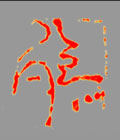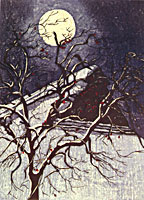When Joshua Rome first came to Japan in 1973, he landed in Tokyo, “looked at all the Kentucky Fried Chicken, McDonald’s, Baskin-Robins,etc.” and as he tells it in the postword to his collection of works - “started asking myself, so where is Japan?”
He did not find it in Kyoto where he soon saw that “the tranquility of the temples and their gardens was totally antithetic to the world outside.”
And he certainly did not find it in Buddhism. “I am sure that if Dogen, Shinran or Nichiren were to see a Buddhist monk behind the wheel of a Mercedes Benz, they would be as appalled as I was shocked by the dualistic nature of modern Japanese Buddhism.”
Then - by now living in the outskirts of Kyoto - he began to realize that Japan was all around him: in the rice fields. in what was left of agrarian land, in the people who lived on it. “ Farmers after all, can survive without cities and all they contain, but cities cannot survive without farmers.” He had found not only his real Japan, but also his true metier.
For the past 20 years Rome, living with his wife and family in a hamlet of twelve households in the hills northwest of Kyoto. has chronicled the fields, the paddies, the farmhouses of his neighbors. His medium is the traditional woodblock print, a discipline he learned by studying under the Kyoto printmaker Clifton Karhu and by working with fellow artist Daniel Kelley.
Other influences have been, according to Rome, not only Monet - with whom he shares both color values and temperament - but also the even now neglected modern print master, Hiroshi Yoshida.
Like Yoshida (and Monet as well), Rome groups his scene with a precision that renders the composition as spontaneous and “natural” as its subject.
This presentation which respects the nature of the empty field, the abandoned farmhouse, the snow piling on an anonymous rural roof, thus reflects the concern through which Rome has, over the years, adapted his means to the needs of his subject.
One of his first discoveries was that “Echizen washi (paper) is highly over rated” and that hand made long fiber paper was best for his subject. Another perception (one which quite contradicts contemporary practice) is that due to the unevenness of this paper, “each print will be slightly different, with unique qualities of its own.”
Rome also differs from some contemporary printmakers in that he himself performs all the many steps required in each print. The classic masters not only had printers, they also had carvers; some modern artists do not themselves print their blocks but entrust the job to professionals.
Rome’s prints, however, are all handmade. This means much more variation. He can for example and does, cut the blocks differently during the printing. “I just start the edition with an image of what I want in my mind and work with the idiosyncrasies of the materials to form that image.”
When the scene, the block, and the nature of the paper demand, Rome’s printing techniques can be highly expressive. One of his means is a burnishing with the baren that results in the grain of the block showing through the paper. Depending upon the amount of color used used on the block, the result can create the kind of atmosphere so admirable in the works of Yoshida. It is a kind of smokiness - very fit for autumnal scenes amid the fields, as though the very air had weight.
This fitting and startlingly beautiful effect is also created through deliberately limiting color, and then pushing what color is used to its limits. Wabi like in its intention, this limiting to the necessary not only serves well the everyday nature of the subject, but also creates a kind of haiku like sharpness of profile.
Rome’s piled-up snowy roofs have a real heaviness, etched as they are against the nocturnal sky, and this is partially because weight is created by the limitations of two colors, rubbed to their limits, and a lot of white.
This purposeful restriction of means has resulted in more and more atmospheric prints. In Rome’s many snow scenes for example, the gomazuri printing technique creates veils through which we view only what is necessary for us to see. Now, when he speaks of using fewer blocks and colors, this fruitful simplicity can be seen as definitive of his art.
This combination of a nostalgic search with keen critical observation, this description of a layered and atmospheric beauty delineating the square cut-forms of the everyday rural scene, constitutes not only a reconstitution but also a recreation. The real Japan has been found.



![]()
